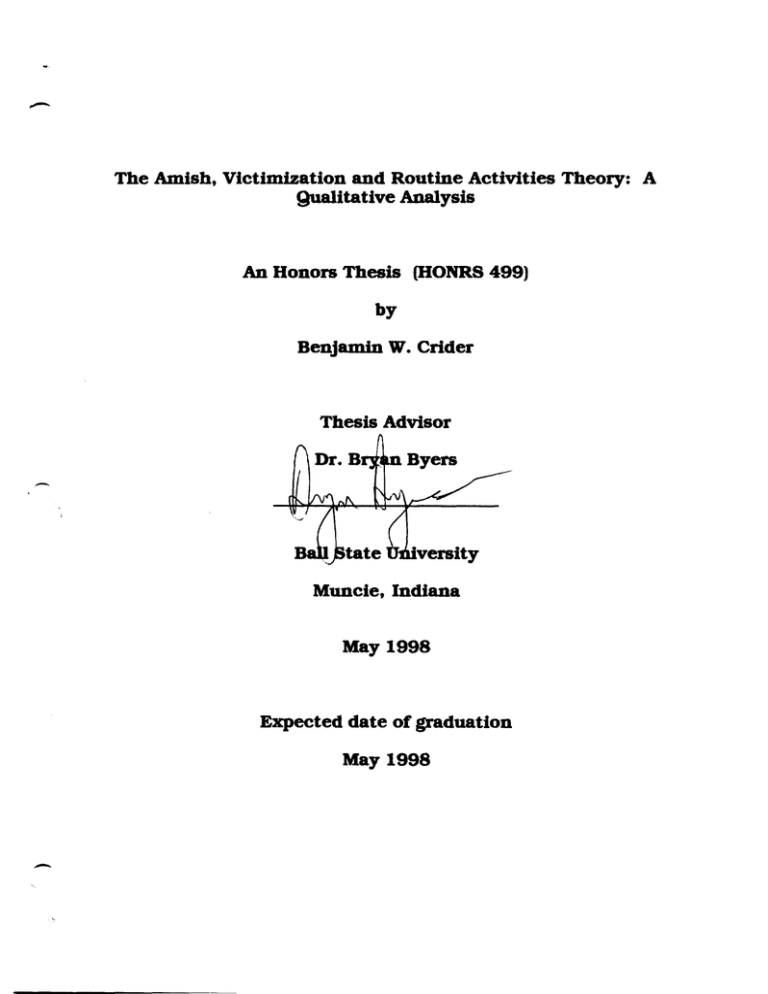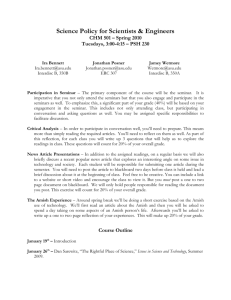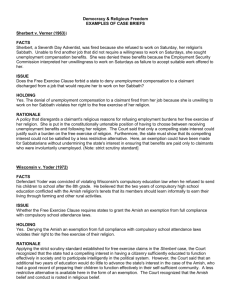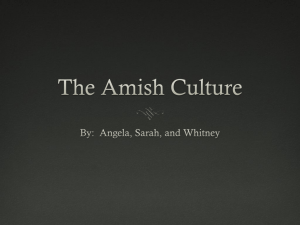The Amish, Victimization and Routine Activities Theory: A Qualitative Analysis
advertisement

The Amish, Victimization and Routine Activities Theory: A Qualitative Analysis An Honors Thesis (HONRS 499) by BenjamiD W. Crider Thesis Advisor Muncie, Indiana May 1998 Expected date of graduation May 1998 - ABSTRACT While the Amish have been well researched within a cultural sense, there has been no study addressing hate crime committed against them. This qualitative analysis uses in-depth interview data of offenders who have engaged in bias crimes against the Amish to address this topic within the theoretical context of Routine Activities Theory. - - Introduction The term "Clape" is a derogatory term used by some non-Amish to Insult/degrade, and demean the Amish. Although this word has unknown ortgIns, it is presently used in Fulham County by offenders who harass, Intimidate, and vandalize the Amish and their property (Fulham County is a fictitious name used to protect the anonymity of the community used in this study). Acts of persecution committed against the Amish are referred to as "Claping." The word "Claping" is derived from the derogatory name "Clape" and refers to various types of assault on the Amish by non-Amish Including racial slurs, property damage. and physical attacks. This study uses qualitative interview methods to elicit responses from offenders who have engaged in various forms of "Claptng". All subjects in this study reSide in the Fulham County area. Fulham County has a well documented history regarding acts of "Claptng." On August 31, 1979 a group of teenagers killed an Amish baby by throwing rocks at an Amish family's horse drawn buggy. This tncident and case were made into a television movie called A Stonlng in Fulham County. This mOvie depicts, rather accurately, an extreme case of the type of incidents which this study examines. The crimes referred to in this study can be defined as "direct contact predatory violations" (Cohen and Feison, 1979). As Glaser (1971, p. 4) explains, a predatory crime occurs when "someone definitely and intentionally takes or damages the person or property of another." Therefore. this study attempts to study predatory crimes committed against the Amish by members of the non-Amish community based on the social identity of the Amish. In a word, this research addresses hate crimes against the Amish Within the theoretical context of Routine Activities Theory. - The Amish: The Amish people are descendants of the Anabaptists of sixteenth 2 century Europe. This was a time in European history when society was dominated by the Reformed church. This led the church of the mainstream to view other groups of religious followers, such as the Anabaptists, as sodal radicals who threatened and challenged their way of religious teachings. This led to Widespread persecution of Anabaptist groups, such as the SWiss MennOnites, by both the Catholic and Protestant Churches. Around 1693, the SWiss Mennonites experienced an ideological split which led to a physical group separation. The person who instigated this split was Jacob Amrnan. Amman was an Anabaptist elder who believed that the religious leaders of the Anabaptists should change some of the well known and practiced religiOUS views of the time. Amman advocated excommunication and the practice of foot washing. Although SWiss Mennonites had used - excommunication as a punishment to those who were unfaithful to the religion, Amman also believed in the practice of Meldung along With excommunicatlon. Meidung is the practice of total social avoidance of those who are excommunicated (Hostetler, 1993). This has come to be known as shunning. Amman took these issues to the leaders of the Anabaptist Church. He demanded that they comply and when they would not, he took 11 upon himself to excommunicate the unwilling leaders, thus separating the Swiss Mennonites into two factions, the Mennonites and the Amish. The Amish mtgrated to America, along with other Anabaptist groups, during the eighteenth and nineteenth centuries to escape religiOUS persecution at the hands of the other religious sects and governments. Therefore, the Amish are a people who live by a doctrine of separation. Their interpret.:'l.tion of the Bible leads them to believe that they must remain - uninfluenced by worldly goals. This means that the Amish must resist the temptation to accept modernity into their lives. They are forbidden to marry 3 outside of the Amish faith. In time of war they are forbidden to fight. They see themselves and claim for themselves the role of conscientious objectors. The Amish view themselves as strangers in the modem world. They belleve that there is no room for the individual and that technology will only get in the way of their faith. Humility and humbleness are their lives. This, however, does not mean that the Amish culture is stagnant. Quite the contrary, the Amish culture is always changing. AmIsh elders realize that if they dq not allow some advancement With technology of the modem world, then they risk community problems and group membership defection. To avoid the modern world as much as possible, the Amish use symbolism to remind themselves and others of their separatism. The horse and buggy are not just a means of transportation. The plain clothes dress and - grooming are not used by the AmIsh just to be fashionably "plain." All of these particular aspects of AmIsh life take on a symbolic meaning. As Hostetler (1993) says: Symbolism is an effective means of social control; the nonconformist can quickly be distinguished from the conformist(p. 236). The symbols of the Amish teach the Amish community how to live. The symbols make sure that the AmIsh never forget that they must live separate from the modem world. Routine Activity Theory Coined by Cohen and Felson (1979) the "Routine Activities Theory" is an approach for analyzing different trends in crime. In this classic work, Cohen and Felson explain three minimal elements needed for there to be any kind of "direct contact predatory violations" (p. 589). These three elements are, the - presence of motivated offenders, the presence of suitable targets, and the absence of capable guardians. Cohen and Felson (1979) note that any absence 4 of anyone of these three elements would be sufficient to stop or prevent a direct-contact predatory crime from occurrtng. That is, each one of these elements is needed for a direct-contact predatory cr1me to be completed. The backbone behind this theory is that the everyday routines of victims make them more visible and more accessible to victims of crime (Hindelang, Gottfredson and Garofalo, 1978). According to Routine Activities Theory, crime is not a random event. When the three elements of motivated offenders. suitable targets, and lack of capable guardians converge, then there will be a predatory crime that occurs. Recently, there has been a prollferation of research on Routine Activities Theory (Anderson and Bennett, 1996; Forde and Kennedy, 1997, Kennedy and Baron 1993; Kennedy and Forde, 1990; Massey, Krohn, and Bonati, 1989; Rountree and Land, 1996; Sherman, Gartin, and Buerger, 1989). These studies -. apply the Routine Activities Theory to crtmtnal victimization in many different ways. For example, Rountree and Land (1996) combine individuals' perceived fear of crime with their everyday "routine" activity to measure vIcttmization. Massey, Krohn. and Bonati (1989) use the Routine Activity Theory to help explatn the victimization of property crime. As Kennedy and Baron (1993, p. 88) state, "research using the routine activities perspectIve has relied on officIal crime statistics victimization surveys, and demographic variables for data." Therefore, most of the research using routine activity is quantitative in nature. This study attempts to take a different approach by qualitatively analyzing offender "accounts" to apply aspects of the Routine Activities Theory to bIas crimes against the Amish. As in a study done by Osgood et. al. (1995), this study differs from the majority of studies conducted which use the Routine Activities Theory for an explanation - of deviant behavior. The study of Osgood et al., although quantitative in nature, is very sImllar to the present study because it examines offender data - 5 to account for criminal victimization. This differs from the majority of studies using the Routine Activities Theory because most other studies use victimization data. Motivated Offenders: According to Massey. Krohn. and Bonati (1989), the idea of motivated offenders is the most difficult of the three elements of the Routine Activities Theory to predict. What exactly constitutes a motivated offender? Massey, Krohn, and Bonati (1989) provide a helpful answer to this question. They suggest replacing the concept of motivated offender With "potential offender" (p. 384). This makes the idea of "motivated offenders" more easy to grasp and to measure. The presence of motivated offenders, although hard to measure, is an important dimension Within any criminal theory because if there are no - offenders who are motivated to commit crime, then there will be no crime. Bennett (1991) describes three dimensions that compose the construct of Motivated Offenders. The first is the physical proxlmity of potential offenders to potential victims. Potential victimization depends very much on offenders being in relatively close contact With their victims. That Is, offenders must be able to reach their victims. The second dimension described by Bennett is offender motivation. That is, offenders must be motivated in one way or another to commit these acts. The third dimension of Motivated Offenders is the number of potential offenders Within an area. The more potential offenders Within an area. the more likely a potential target will be victimized at any given time. These three dimensions of the Motivated Offenders element of the Routine Activitl.es Theory better help to explain how the concept of Motivated Offenders can be operationaltzed. Suitable Targets: A target for a crime mayor may not be an actual person. A target can be - 6 the property of a person, or what ever the offender is seeking to victimize (Felson, 1994). A target that is easily and often visible to a potential offender Is considered a suitable target. Massey. Krohn, and Bonati (1989) speak of the "hardening" of a target. The "hardening" of a target refers to some form of protection that makes the target "harder" for an offender to v1ctimize. Moreov~r, Ll}e less "hard" that a target is, the more "easy" the target becomes to vtct1m1ze therefore. making the target more suitable. Target-hardeners can be anything from security devices to a family dog that wards off intruders by barking. According to Bennett (1991) both desirability and target accessibility are important factors that contribute to making a target more "suitable." The desirability of a. target has to do with "the material or symbolic desirability of the item to the potential offender" (Bennett, 1991, p. 148), Therefore, target accessibility involves the "physical visibility and accessibUity of the crime object to the potential offender" (p. 148). Further. and according to Bennett, the accessibility of a target has to do with the target's ability to withstand attack. That is, if the target cannot. or will not, reSist attack, it is considered an "easy target." Lack oj Capable Guardians: As Felson (1994) points out. a guardian is not only a person who has the formal role of protection, such as a police officer. GuardianS are also citizens. Guardians can be friends, strangers, or anyone who may be in the vicinity who can discourage a crime from occurring. According to Massey. Krohn, and Bonati (1989) capable guardians should not be confused with target-hardening measures. According to Massey et al. (p. 386): Note here that these factors [of capable guardians} are different - from the target-hardening tactics alluded to above. These are not operations performed on the physical target itself (e.g. barring' - 7 windows, erecting fences, locking doors) but actual overt activities that affect the likelihood of victimization. In short, a capable guardianS can be anyone who has the power, or means, to discouraging a crime. This could even include the potential victim. Research Questions This research addresses the theory of Routine Activities and how this theory may apply to the victlmization of Amish, or "Claping." Three research questions are examined within this study. These are: Research Question 1: Why are offenders motivated to engage in "Clap1ng?" Research Question 2: Do offenders who participated in claping perceive that - there is a lack of capable guardians to protect the Amish? Researcb Question 3: To what extent do offenders who participated in "Claping" see their Amish victims as Suitable Targets? Methods This study uses qualitative interview methods to elicit accounts from offenders who have engaged in Claping against the Amish. These accounts are then analyzed for aspects of Routine Activities Theory. Eliciting accounts from offenders has been used successfully In the past. Stamp & Sabourin (1995) used offender accounts to understand how abUSive men perceive their violent behavior. Similarly, Gonzales, Haugen, & Manning (1994) used accounts to study "the effects of offender blameworthiness" (p. 691). Sampling and Interview Methodology The subjects for this study were obtained through personal contacts and - confidential1nfc)rmants. All subjects agreed to participate in this study on a voluntary basis. In all, there were eight subjects interviewed. Each subject - 8 participated in a face to face interview. Each audiotaped interview lasted approxtmately two hours. The audio tape of each interview was then transcribed and analyzed according to the research questions for this particular study. The subjects were all white males Within the age range of 1727. As is often the case in qualitative research (Maxfield & Babbie, 199B), the sample size grew as the study grew. This was a result of the investigators asking each subject if they knew anyone who would be willing to participate in the study. Each subject for this study was required to read and sign an informed consent form. All data and subject information for this study was kept, and will remain, confidential. Permission to conduct this study was granted by the Ball State Institutional ReView Board. - The interview schedule for this study used open ended questions. By using this type of approach, there was structure to the interviews, but this structure was flexible enough to allow the subjects to fully explain their experiences, thoughts, and conclUSions. For a copy of the interview schedule, see the Appendix. Data and Findings Analysis After the interview data was transcribed, each subject's transCript was read and examined for pertinent information to the research questions. Selected quotes were then taken from the transcripts. Motivated Offenders As mentioned earlier, according to the Routine ActiVities Theory a suitable number of potential, or motivated offenders must be present in order for a crime to occur. The offenders interviewed Within this study gave several - different reasons for why they were motivated to commit these acts against the Amish. Some of the offenders based their motivation on how the Amish are - 9 "different." For example: I think it was just boredom and they were different and they were an opportunt4/ to pick on someone. (Sub1ect 1) [thlnkjor the most part just because they were Amish was the reason that we picked on them for the most part. (Sub1ect 2) I guess I looked at them as not really being a part oj society in a way it is like, we can pick on them because they are so dtfferent. (Subject 2) One offender placed a portion of his motivation for engaging in Claptng on the advance of his own social identity: In a small society. like ours, it was a way to identify yourself. To go out and cause trouble, create mischi~f against the Amish was really a way to do that. It just made you look cool. (Subject 2) Other subjects explained that they committed these acts for "fun" and "adventure": I would say,jor me it would be less attitude and more adventure. [mean, [ at the time dtdn't carefor them and all that klnd qf stl!:ff. [.lust remember that It was jun doing what we did and that was what. It was more oj the high there from getting caught doing something to somebody than it was on hurting the Amish. (Subject 3) We were}ust outjor jun. [mean, we dtdn'tjeel bad, it wasjun. (Subject 5) It wasjust going out and havingjun. It wasjust mischief. You want to cause trouble but the odds are that you probably aren't going to get caught and that is the best kind ojmischiejthat there is. (Subject 5) Still other subjects suggested that their motive was based on the idea that there was nothing else to do: Just something to do. They were there. You hear that a lot oj times. F'ifteen or sixteen year old kids that had nothing to do. (Subject 5) Because [was probably with a lotojmyjrtends and we werejust looking jor something to do and they were doing it and I was doing it so we were all doing it. (Subject 7) - Well [ think that the majority oj them was just mischief. Just going out. A lot of things that I did then I probably wouldn't go out and do now. They were kind ojjust one oj them things that you are younger and there is not much to do around here so you just go out and cause some trouble and I think that that was 10 the majority of it. Every now and then if there was a bunch qf Amish driving in the middle oj the road, you might yell, "Get the **** off the road ... or something like that but asJar as going out, I don't see myself ever going out and smashing mailboxes again or hosing them down withflre extinguishers. Right now, I don't have any need to do it anymore. (Subject 8) Finally. other offenders were motivated for reasons that the AmIsh were somehow deserving of this treatment, either because of something that a specific Amish person had done to them, or for something that the Amish as a whole engage in which the offender finds disturbing. The dusting, or trying to spook the horse, or whatever, in some cases I would almost justify that because oJtheJact that they were in the middle oJ the road. (Subject 3) - Well, I mean, they would sit there and pick on me and I thought that yes I had the right to pick on them back. Then you know, it kind oJjust spread to not just piCJcing on them, I'm going to go pick on another one just because that I was havtngJun dotng it. I mean. you know, [ got my revenge and [ liked what I was doing so [just kept on doing it. (Subject 4) Well like the certain ones that we would terrortze and stuff, they were hypocritical. [mean that is how IJelt then. There are regular people who are the same way and I never dld it to them. The Amish you know they don't have electricity and they have it coming because they don't believe in electrlcity but they will sit down and watch TVJor three hours. And I've had it done, they will come and watch TV at your houseJor a while. [believe that ifyoufeel that you shouldn't have a TV then you shouldn't watch it period. IJeel that if they do this then they have it coming. (Subject 6) This data suggests that there are five basic reasons that offenders are motivated to engage in Claping against the AmIsh. First, the Amish are different and therefore offenders are motivated to "pick on" the Amish based on real or perceived differentness. Second, people who engage in these acts against the Amlsh are seen as "cooler" or higher up in the social hierarchy than people who do not engage in this behavior. Third, many offenders said that they "did it" for fun and adventure. It was an "adrenaline rush" to harass, - intimidate, and assault the AmIsh. Fourth, a few offenders saw the Amish as deserving of victimization, either for reasons of revenge, or because they saw - 11 the Amish as hypOCrites. Finally. there was some consensus among the subjects that there was nothing better to do. They felt that when kids within this community had nothing to do, this is what they did, victimize the Amish. Lack of Capable Guardians Within the community under study, victimization of the Amish is sometimes considered a "rite of passage." ThIs helps to account for why there is a lack of capable guardians. If no one in the community believes that what these young offenders are doing is wrong, then why would they want to take action in protecting the Amish victims? These crimes were often committed late at night, on rural county roads. This contributes to the idea of the lack of capable guardians because likelihood of an ordinary citizen or police officer being in the vicinity to stop these events from taking place is very slim. - Many offenders within this study observed or perceived that the reason that many Amish are victimized Is because there is no one around to protect the Amish from offenders such as themselves. This gave the subjects the impression that there was no need to worry about getting into any kind of trouble while they were committing these acts because no one was around to discourage these acts. For example, some subjects offered these statements: We used to just say, "Let's go out and raise some hell." And then that would just be part oj it. I think we just did it against the Amish because we knew that we wouldn't have to run into them or we wouldn't see them in town. We really didn't know who they were at all. You know. So there wasn't any possibility oj them. there was the least possible that you would get in trouble I guess. (Subject 2) So the risk were low? (Interviewer) Yes. They were out in the country. It was dark out there and no one was out there, it is not in town. They can't call police or anything. (Subject 2) And they wouldn't likely do that? (Interviewer) And they wouldn't likely do that anyway. So they were kind oj removed Jrom SOCiety so we went out and messed with them. The riSks were not that high. (Subject 2) 12 -. So there was a high probability of getting away with it? (Interviewer) Yes. (Subject 2) This subject went on to state: It was kind of like we could really go out and raise hell without getting in trouble. (Subject 2) That was why they [the Amish} were so easy to pick on. No one really cared. No one really valued how they lived. (Subject 2) One subject suggested that since the police officers within the community were probably locals, they to had engaged in Claping at one time or another and were probably less likely to pursue anyone who was harassing the Amish: I would say, well. When we were still in high school I know almost all the cops were still pretty much locals. I would say that they have probably have their fair share of claplng or at least maktngfun of them. (Subject 3) - When asked why the Amish are targeted, this same subject gave some insightful information into the lack of capable guardIans within the community under study: It is soclally acceptable here. (Subject 3) Do you think so? (Interviewer) Extremely. (Subject 3) In this community? (Interviewer) Extremel!l. in this community. They just pretty much just shrug and it is boys growing up. if I lived here and I had kids and they were sixteen or seventeen, then it would not surprise me is Ijust said it isjust kids growing up. (Subject 3) Following the same theme as the previous statements regarding how the community views this type of behavior, one subject stated: - A local probably wouldn't criticize you. Well, they criticize you on certain acts. For certain acts they would laugh. Like my dad, I used to tell him that I did stuff. He never criticized mefor it. He did the same thing when he was my age. (Subject 5) -- 13 Other subjects placed some of the blame for the lack of capable guardians on the AmiSh themselves. The offenders knew that the Amish have no interest in calling the police to press charges. This Is evident from statements such as: The possibilities were low that you were ever going to get caught. did, they weren't going to press charges against you. (Subject 4) if you It was just ktnd of like you knew that you weren't going to get into trouble for it. So therefore, that is probably another reason that you did it. They weren't going to go in to the local police and if they actually didftnd someone to call, we were long gone. (Subject 5) In summary, the subjects interviewed agreed that there is a lack of capable guardIans when it comes to protecting the Amish. The events of Claptng usually took place on dark rural roads where there was no one to Intervene. The subjects agree that the community sees these events as normal, and just "boys growing up." And the religIon of the Amish does not allow them to press charges, therefore making it very unlikely that the Amish will call the police. Suitable Targets The Amish and their day-to-day activities, or routine activities, make them very noticeable to others within their community. The symbolism of the Amish, that is the way they dress, their horse and buggies, etc., make them visible to potential, or motivated, offenders. The fact that they do not have the protection that cars, telephones, and electronic security devices offer makes them easy, or suitable, targets for direct contact predatory crime. All eight subjects commented on the Amish as being suItable targets. One subject mentioned that the Amish are suitable targets for mailbox smashing because of the relative size of their mailboxes: - I think another thing is that they are targetsfor mailbox smashing. They have some big huge mailboxes and we did that afew times. (Subject 1) 14 Many subjects stated that the reason for choos1ng an Amish person to harass was the lack of consequences. The subjects felt that the AmIsh people have no way of subject1ng the offenders to any type of penalties. For example: A target that you realize that there are not going to be any consequences. No one will everJina out unless I tell them about it. That I swerved out. I swerved at an Amish kid out in the middle oj no where, you know. There was pretty much no one around. There's really not going to be any consequences that I'm going to get in trouble about, you know. So I went ahead ana did it. I realize that it is probably, you know I think about it at the time but there is really, I thought that there is really no way that he can get back to tell anybody that I know to get me in trouble by it. (Subject 2) It is easier to pick on someone with lower status ana weaker and vulnerable. And then we had a thing of not really having any way oj getting back at you. There really wasn't any way of getting back at you. (Subject 2) They can 't sit there and call the cops on me once you like break one of their windows or something or you blow up their mailbox or whatever. They can't call the cops, you know, they are just an easy target. (Subject 4) Because we knew that they wouldn't do nothing [sic] about it. They didn't believe in preSSing charges and stuJf. We just kept terrorizing them over ana over because we kn.£~w that we could just get away with it. (Subject 6) I really didn'tjeel that maybe they had it coming to them but as I said earlier, they are an easy target. They oJfer an easy target because they turn the other cheek and don'tflght back. So they are a real easy target and asjar as being mischievous they are easy to go out and pull pranks on and stuff. So that might be why they had it coming to them because they are really easy people to go out and harass and makefun oj. Just because they weren't going toftght back and you knew that they weren't going to. (Subject 8) They almost set themselves up like I said earlier. They are easy targets and they are not going toflght back. A young mischievous person kind ofJinds thatjun to go out and pull a prank on them. (Subject 8) Some subjects explained that the reason Amish people are targeted for these types of crimes is because of the perceived differentness of the Amish. Such as: I guess we looked at it as they are not as developed or anything. They are lacking technology. I guess it really much boils down to it was different, it was totally different. It was an easy target to just go over and push over. (Subject 2) Why were they easily targeted? (Interviewer) - 15 The plain and simplefact that they were just d!fferent than we were. (Subject 3) What do you mean by d!fferent? (Interviewer) They lived d11ferently. They act d11ferently or supposedly act d11ferently. They lookd!1ferent. (Subject 3) The main reason why we chose them is because they were and easy target and they were d!fferent, they did everythlng dfJferentfrom us. They didn't dress the same way. A lot of them stunk and smeUed real bad. They areJust dtfferent from you. (Subject 4) One subject tried to explain this perceived differentness of the Amish. When asked if the subject can easily tell who is an Amishman and who Is not, the subject replied: if there where a million people standing around and one Amishman, I could plek him out. (Subject 7) What if you took an Amish and put like a pair of shorts and a t-shirt, would that change it? (Interviewer) You can telL You could still teU. They act d11ferent. (Subject 7) I mean, their horse and buggy is movingflve miles per hour down the road. They are just a prime target I guess. Easy pickings. (Subject 7) Other subjects made comments about how easy the Amish are to target for assault, harassment, and vandalism. I mean, something they were easy, Just an easy target you know. You would be out and with yourfriends one night and like I said before got bored and had a good time. (Subject 4) They were there. And they were convenient. (Subject 5) - Mainly due to the part that you have these slow moving vehleles, you know where they are at. You are coming down the road and you see their blinkers. They are easy targets. They are going slow, the chances of gelling away are real good, and by the time that they get to a phone, you can be home and be in bed. By the time that they get to a phone and the pollee are out after you, at leastfor a random act, by the time they got somewhere to where you could probably get into trouble, you would be long gone. (Subject 5) Could you descrlbefor us the reasons that you selected an Amishpersonfor this type of act? (Interviewer) - 16 They are easy to pick on. (Subject 7) It is clear from the aforementioned data that the offenders within this study see the Amish as easy targets. The offenders know that the Amish religion teacbes the AInisb not to fight back or not to press charges against anyone. The Amish believe that it is God's job to punish people for their wrong doings. The offenders within this study knew this and they used it t.o their advantage in targeting the Amish. The offenders knew that this made the Amish very vulnerable. Another theme that emerged from the suitable target dimension data of the Routine Activities Theory is that of "target hardening" measures. The subjects consistently mentioned that since the Amish use a horse and buggy for their method of transportation, the Amish are very vulnerable to harassment while on the road. The horse and buggy does not fall - within the definition of a "hard target." In short, the faith of the Amish is exactly what makes them a suitable target for these types of offenses. Because of the unique beliefs of the Amish. the Amish as a group are much more vulnerable to these types of crimes than are other ethnic and/ or minority groups. Conclusion It is clear from the information prOvided by the subjects of this study that the Routine Activities Theory has applications in hate crimes of "Claping" against the Amish. For the first research question, (Why are offenders motivated to engage in "Claping?") five basic reasons for motivation were prOvided by the subjects. These five reasons that the offenders gave are because the Amish are different, because Claping makes the offenders feel as though they have a higher social status, because it was fun, the Amish deserved it, and there was nothing else to do. For research question number two, (Do offenders who participated in 17 Claping perceive that there is a lack of capable guardians to protect the Amish?} the subjects who volunteered for this study saw neither the police, nor people of the community as any kind of a threat when it came to stopping themselves or other youths from engaging in acts of Claping. Their responses of how easy it was to get away With these types of acts supports the idea that there is a lack of capable guardians Within the community under study. The third research question (To what extent do offenders who participated in "Claptng" see their Amish victims as Suitable Targets?) was undoubtedly the research question that was answered With the most certainty. Every subject interviewed made at least one comment on how "suitable" the Amish are as targets. The reasons that the Amish appealed to these offenders, such as slow moVing Amish buggies and not calling the police, all stem from - how the Amish live their lives based on Ordung (the rules of Amish life). The Amish faith dictates how the Amish live. This means that the Amish are not allowed to drive cars, own telephones, or press charges against perpetrators. Compared to other minority groups, by way of their religion, the Amish are probably the easiest, or most "suitable" targets for the types of hate crime activities mentioned within this study. The perceived differentness of the Amish was also an important factor which made the Amish targets for the offenders within this study. Because of how the Amish dress, and because of their method of transportation, the Amish were very easy for offenders to dIstinguIsh from other members of the communIty. This adds to the vulnerability of the Amish making them an even easIer target for hate crime victimization. Study Strengths The strengths of this research are quite numerous. First of all, this - study sheds some light on a very under researched topIc. Because the Amish try to live their Uves away from media attention, they have not receIved much - 18 attention by researchers, or anyone else for that matter. The qualitative indepth interview process Is also a strength to this study. This technique allowed the researchers to elicit lengthy, detailed responses from subjects. This resulted in a very fruitful data set. Another strength of this study stems from the fact that offenders of this type of crime are very hard to find. It is very dtfilcult to get these offenders to speak openly about the crimes that they committed. The researchers who interviewed these offenders were able to gain the trust of the subjects. This bond of trust resulted in data that is normally not accessible to people "outside" of the group. Study Weaknesses One wealmess of this study may at first seem to be the limited number of subjects that were interviewed. This, however, is not seen as a significant weakness due to the fact that this is a qualitative research project. It is not .- unusual to have small numbers of subjects for qualitative projects. Since the offenders of these types of hate crimes are small in number, and relatively hard to gain access to, eight subjects is a suffiCient number. Another weakness of this particular study is that all subjects were from the same community. Since this is the case, it is not suggested that the data from this study be generalized to other Amish communities. Suggestions to Future Researchers This type of research on Amish and offenders who victimtze the Amish, should be applied to other Amish communities other than the community used wlthin this study. This is why such exploratory research is so important. This research can be used as a gUide for future researchers who may want to study similar phenomena. If other Amish communities are studied, then the data and results from those studies can be compared and contrasted With the data - and findings from this study. To study offenders who have engaged in claplng. it Is important to - 19 remember how difficult it can be to gam entry to such groups. Researchers must find someone who can provide access into the group. It is then the researcher's responsibility to gain, and maintain, the group's trust. - - - 20 References Anderson, T. L., & R. R. Bennett. (1996). "Development, Gender, and Crime: The Scope of the Routine ActiVities Approach." Justice Quarterly. 13: 31-56. Bennett, R. B. (1991). "Routine ActiVities: A Cross-National Assessment of a CriminologIcal Perspective." SocIal Forces. 70: 147-163. Cohen, L.E., & M. Felson. (1979). "Social Change and Crime Rate Trends: A Routine ActiVity Approach." American SocIological Review. 44: 588-611. Felson, M. (1994). Crime and Everyday Life. Thousand Oaks, CA: Pine Forge Press. - Forde, D. R. & L. W. Kennedy. (1997). "Risky Lifestyles, Routine ActiVities, and the General Theory of Crime." Justice Quarterly. 14: 265-294. Gonzales, M. H., J. A. Haugen, & D. J. Manning. (1994). "VIctims as 'Narrative Crtties f : Factors Influencing Rejoinders and Evaluative Responses to Offenders' Accounts." Personality and Social Psychology Bulletin. 20: 691704. Glaser, D. (1971). SocIal DeViance. ChIcago: Markham. Htndelang, M., M. Gottfredson, & J. Garofalo. (1978). VIctimS of Personal Crime. Cambridge. MA: Ballinger. - Hostetler, J.A. (1993). Amish SocIety. Fourth Edition. Baltimore: Johns Hopkins UniversIty Press. 21 Kennedy, L. W., & S. W. Baron. (1993). "Routine Activities and a Subculture of Violence: A Study of Violence on the Street." Journal of Research in Crime and Delinquency. 30: 88-112. Kennedy, L. W., & D. R. Forde. (1990). "Risky Lifestyles and Dangerous Results: Routine Activities and Exposure to Crime." Sociology and Social Research: An International Journal. 74: 208-210. Massey, J. L., M. D. Krohn, & L. M. Bonati. (1989). "Property Crime and the Routine Activities of Individuals." Journal of Research in Crime and Delinquency. 26: 378-400. - Maxfield, M. G., & E. Babbie. (1995). Research Methods for Criminal Justice and Criminology. Belmont, CA: Wadsworth. Osgood, D. W., J. K. Wilson, P. M. O'Malley, J. G. Bachman, & L. D. Johnston. (1995). "Routine Activities and Individual Deviant Behavior." ForthCOming in the American Sociological Review. Rountree, P. W., & K. C. Land. (1996). "Perceptions of Crime Risk, and Routine Activities: A Multilevel AnalysIs Across Seattle NeIghborhoods and Census Tracts." Journal of Research in Crime and Delinquency. 33: 147-180. Sherman, L. W . , P. R. Gartin, & M. E. Buerger. (1989). "Hot Spots of Predatory Crime" Routine Activities and the Criminology of Place." - Criminology. 27: 27-55. 22 Stamp, G. H., & T. C. Sabourin. (1995). "Accounting for Violence: An Analysts of Male Spousal Abuse Narratives." Journal of Applied Communication Research. 23: 284-307. -- .- 23 APPENDIX Routine Activities Theory Questions General 1. Why did you engage in. or participate in. the "Claptng"? Target 2. Could you describe for us the reasons why you selected an Amish person for this type of act? Opportunity 3. How was it that you had the chance or opportunity to engage in this act/thes(~ - acts? Lack of Capable Guardians 4. Why are the Amish targeted? 5. Are there reasons why it is easy to get away with it?





